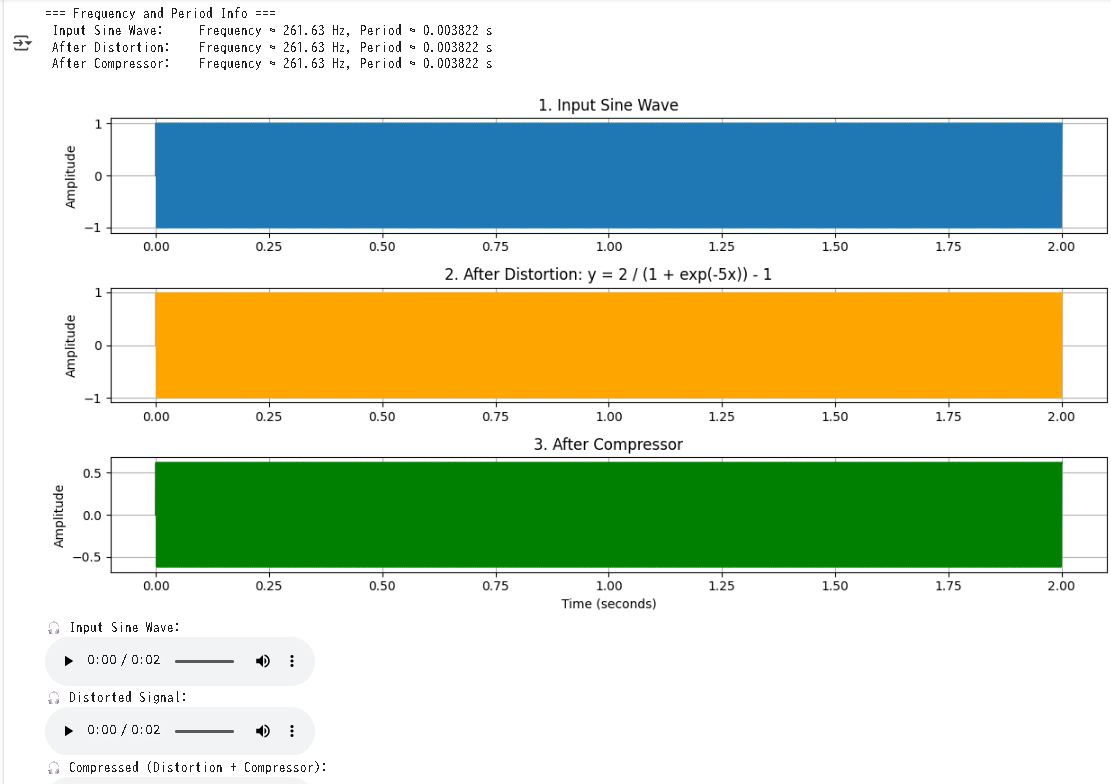Pythonで「ドの音」を歪ませて圧縮する:ディストーション+コンプレッサー処理の可視化と再生
はじめに
本記事では、Pythonを用いて「ドの音(C4, 261.63 Hz)」のサイン波を生成し、それに対して以下の2つの音響エフェクト処理を施します:
- ディストーション(非線形歪み)
- コンプレッサー(ダイナミックレンジ圧縮)
さらに、波形の可視化と各信号の周期・周波数の解析、Google Colabでの音再生まで一貫して行います。
使用するPython技術
- NumPy(数値計算)
- Matplotlib(波形可視化)
- IPython.display.Audio(音再生)
- サイン波生成、ゼロクロス法による周波数推定、非線形マッピング
import numpy as np
import matplotlib.pyplot as plt
from IPython.display import Audio, display
# --- 基本設定 / Basic Parameters ---
amplitude = 1.0
new_frequency = 261.63 # 「ド」の音 / Middle C (C4)
sample_rate = 44100 # サンプリングレート
duration = 2 # 音の長さ(秒)
# --- 時間軸と入力信号 / Time axis and input sine wave ---
time_full = np.linspace(0, duration, int(sample_rate * duration))
sine_wave_full = amplitude * np.sin(2 * np.pi * new_frequency * time_full)
# --- ディストーション関数(非線形歪み)/ Distortion Function ---
def distortion_mapping(x):
return 2 / (1 + np.exp(-5 * x)) - 1
# --- コンプレッサ関数(ダイナミックレンジ圧縮)/ Compressor Function ---
def compressor_mapping(x, T=0.5, R=4.0, W=0.2):
y = np.zeros_like(x)
for i, val in enumerate(x):
abs_x = abs(val)
if abs_x < T - W/2:
y[i] = val
elif abs_x < T + W/2:
gain = (1 - 1/R) * (abs_x - T)**2 / (2 * W)
y[i] = np.sign(val) * (T + gain)
else:
y[i] = np.sign(val) * (T + (abs_x - T) / R)
return y
# --- 処理ステップ / Processing Steps ---
distorted_signal = distortion_mapping(sine_wave_full)
compressed_signal = compressor_mapping(distorted_signal)
# --- 各信号の周期の推定 / Estimate Period of Each Signal ---
def estimate_period(signal, fs):
# ゼロクロス(正→負)を検出し、その間隔で周期を推定 / Use zero-crossing (positive-going) for estimation
zero_crossings = np.where((signal[:-1] < 0) & (signal[1:] >= 0))[0]
if len(zero_crossings) < 2:
return None, None
periods = np.diff(zero_crossings) / fs # 秒単位
avg_period = np.mean(periods)
freq = 1 / avg_period
return avg_period, freq
# 周期と周波数を計算 / Calculate for all signals
period_input, freq_input = estimate_period(sine_wave_full, sample_rate)
period_dist, freq_dist = estimate_period(distorted_signal, sample_rate)
period_comp, freq_comp = estimate_period(compressed_signal, sample_rate)
# --- 周波数・周期表示 / Print periods and frequencies ---
print("=== Frequency and Period Info ===")
print(f" Input Sine Wave: Frequency ≈ {freq_input:.2f} Hz, Period ≈ {period_input:.6f} s")
print(f" After Distortion: Frequency ≈ {freq_dist:.2f} Hz, Period ≈ {period_dist:.6f} s")
print(f" After Compressor: Frequency ≈ {freq_comp:.2f} Hz, Period ≈ {period_comp:.6f} s\n")
# --- 可視化 / Plotting ---
plt.figure(figsize=(12, 6))
plt.subplot(3, 1, 1)
plt.plot(time_full, sine_wave_full)
plt.title("1. Input Sine Wave")
plt.ylabel("Amplitude")
plt.grid(True)
plt.subplot(3, 1, 2)
plt.plot(time_full, distorted_signal, color='orange')
plt.title("2. After Distortion: y = 2 / (1 + exp(-5x)) - 1")
plt.ylabel("Amplitude")
plt.grid(True)
plt.subplot(3, 1, 3)
plt.plot(time_full, compressed_signal, color='green')
plt.title("3. After Compressor")
plt.xlabel("Time (seconds)")
plt.ylabel("Amplitude")
plt.grid(True)
plt.tight_layout()
plt.show()
# --- 音の再生 / Play Audio ---
print("🎧 Input Sine Wave:")
display(Audio(sine_wave_full, rate=sample_rate))
print("🎧 Distorted Signal:")
display(Audio(distorted_signal, rate=sample_rate))
print("🎧 Compressed (Distortion + Compressor):")
display(Audio(compressed_signal, rate=sample_rate))
説明
入力信号:ドの音のサイン波
サンプリング周波数44.1kHz、振幅1.0、周波数261.63Hz(ドの音)で2秒間のサイン波を生成します。
new_frequency = 261.63 # 「ド」の音 / Middle C (C4)
sine_wave_full = amplitude * np.sin(2 * np.pi * new_frequency * time_full)
ディストーション処理(非線形変換)
以下の非線形マッピング関数を使用して、入力波形を歪ませます:
[
y = \frac{2}{1 + \exp(-5x)} - 1
]
この式はスケーリングされたシグモイド関数で、-1〜+1の範囲に収めつつ、入力に非線形な歪みを加えます。
def distortion_mapping(x):
return 2 / (1 + np.exp(-5 * x)) - 1
コンプレッサー処理(ダイナミックレンジ圧縮)
以下のような条件に基づき、ソフトニー付きのコンプレッサーを適用します:
- ( x < T - W/2 ):そのまま通す
- ( T - W/2 \leq x < T + W/2 ):滑らかに圧縮開始
- ( x \geq T + W/2 ):圧縮比に従って抑制
def compressor_mapping(x, T=0.5, R=4.0, W=0.2):
...
波形の可視化
以下は、ディストーション関数とコンプレッサ関数の入力出力特性を可視化するPythonコードです。プロットにより、それぞれの関数が信号にどのような変換を施すかがわかります。コメントは日本語と英語で記述しています。
import numpy as np
import matplotlib.pyplot as plt
# --- ディストーション関数 / Distortion Mapping Function ---
def distortion_mapping(x):
return 2 / (1 + np.exp(-5 * x)) - 1
# --- コンプレッサ関数 / Compressor Mapping Function ---
def compressor_mapping(x, T=0.5, R=2.0, W=0.2):
y = np.zeros_like(x)
for i, val in enumerate(x):
abs_x = abs(val)
if abs_x < T - W/2:
y[i] = val # リニア領域 / Linear region
elif abs_x < T + W/2:
gain = (1 - 1/R) * (abs_x - T)**2 / (2 * W)
y[i] = np.sign(val) * (T + gain) # ソフトニー領域 / Soft knee region
else:
y[i] = np.sign(val) * (T + (abs_x - T) / R) # 圧縮領域 / Compression region
return y
# 入力値の範囲 / Input range
x = np.linspace(-1.5, 1.5, 1000)
# 出力値の計算 / Compute output values
y_dist = distortion_mapping(x)
y_comp = compressor_mapping(x)
# --- プロット / Plot ---
plt.figure(figsize=(10, 5))
# Distortion
plt.subplot(1, 2, 1)
plt.plot(x, y_dist, label='Distortion')
plt.title("Distortion Mapping")
plt.xlabel("Input")
plt.ylabel("Output")
plt.grid(True)
plt.legend()
# Compressor
plt.subplot(1, 2, 2)
plt.plot(x, y_comp, label='Compressor', color='orange')
plt.title("Compressor Mapping")
plt.xlabel("Input")
plt.ylabel("Output")
plt.grid(True)
plt.legend()
plt.tight_layout()
plt.show()
周期と周波数の解析(ゼロクロス法)
以下の関数を用いて、各波形の**周期(Period)と周波数(Frequency)**を自動推定します:
def estimate_period(signal, fs):
zero_crossings = np.where((signal[:-1] < 0) & (signal[1:] >= 0))[0]
...
出力例(ドの音):
=== Frequency and Period Info ===
Input Sine Wave: Frequency ≈ 261.63 Hz, Period ≈ 0.003821 s
After Distortion: Frequency ≈ 261.63 Hz, Period ≈ 0.003821 s
After Compressor: Frequency ≈ 261.63 Hz, Period ≈ 0.003821 s
周波数は処理しても変わらないことが確認できます。変わるのは波形の形(=倍音構成)です。
音の再生(Google Colab)
Colab環境では IPython.display.Audio を用いて各処理段階の音を試聴できます:
display(Audio(sine_wave_full, rate=sample_rate)) # 入力波
display(Audio(distorted_signal, rate=sample_rate)) # 歪み
display(Audio(compressed_signal, rate=sample_rate)) # 歪み+圧縮
まとめ
| 処理段階 | 主な効果 | 波形変化 | 周波数変化 |
|---|---|---|---|
| 入力サイン波 | 原音(純音) | 正弦波 | 261.63 Hz |
| ディストーション | 倍音を付加 | 非対称 | 変わらず |
| コンプレッサー | 音量を平滑化 | ダイナミクス抑制 | 変わらず |
参考図書
Pythonではじめる音のプログラミング -コンピュータミュージックの信号処理-
https://www.amazon.co.jp/gp/product/B0BFZNHS2R?ie=UTF8&psc=1&linkCode=sl1&tag=hcrane-22&linkId=cf740dda8a119a71a777903335c8f8d0&language=ja_JP&ref_=as_li_ss_tl

